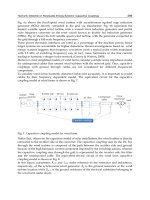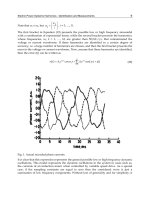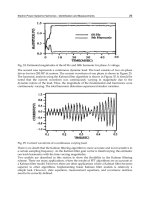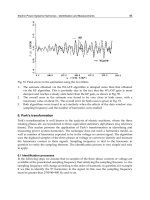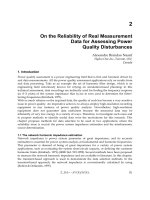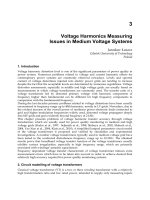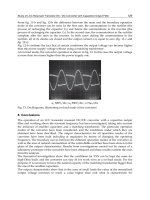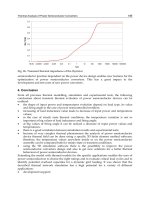Power Quality Monitoring Analysis and Enhancement Part 3 docx
Bạn đang xem bản rút gọn của tài liệu. Xem và tải ngay bản đầy đủ của tài liệu tại đây (736.93 KB, 25 trang )
3
Power Quality Measurement Under
Non-Sinusoidal Condition
Magnago Fernando, Reineri Claudio and Lovera Santiago
Universidad Nacional de Río Cuarto
Argentina
1. Introduction
The interest on problems related to non linear devices and their influence on the systems
increased considerably since 1980. This is due to the development of new power
semiconductor devices and, as a consequence, the development of new converters that
increment the non linearity in electric power signals substantially (Arrillaga et al., 1995).
Several research institutions have estimated that seventy percent of all electrical power
usage passes through a semiconductor device at least once in the process of being used by
consumers. The increase on the utilization of electronic equipment modified the sinusoidal
nature of electrical signals. These equipments increase the current waveform distortion and,
as a consequence, increment the voltage waveform distortion which causes over voltage,
resonance problems in the system, the increase of losses and the decrease in devices
efficiency (Dugan et al., 1996).
In general, quantities used in electrical power systems are defined for sinusoidal conditions.
Under non sinusoidal conditions, some quantities can conduct to wrong interpretations, and
others can have no meaning at all. Apparent power (S) and reactive power (Q) are two of the
most affected quantities (Svensson, 1999). Conventional power definitions are well known
and implemented extensively. However, only the active power has a clear physical meaning
even for non sinusoidal conditions. It represents the average value of the instantaneous
power over a fix period. On the other hand, the mathematical formulation of reactive power
may cause incorrect interpretation, aggravated when the analysis is extended to three phase
systems (Filipski, 1984; Emanuel, 1999).
Although definitions of apparent, active, and reactive power for sinusoidal systems are
universally accepted, since IXX century researchers pointed out that the angle difference
between voltage and current produces power oscillation between the source and the load.
All these research effort remark the importance of the power factor and the reactive power
on the optimal economic dispatch. One of the initial proposals consists on dividing the
power term into active, reactive and distortion power, and was the most accepted one. In
the 80´s the discussion about the definitions mentioned above increased because the use of
non linear loads incremented considerably. Although many researchers remark the
important implications of non sinusoidal conditions, up today it is very difficult to define a
unique power definition for electric networks under distorted conditions. The lack of a
unique definition makes that commercial measurement systems utilize different definitions,
Power Quality – Monitoring, Analysis and Enhancement
38
producing different results, and as a consequence, generates significant economic effects
(Ghosh & Durante, 1999; Cataliotti, 2008). Therefore, measurement systems, may present
different results, not only because of different principle of operation, but because of the
adoption of different quantities definitions as well.
This chapter presents a critical review of apparent power, reactive power and power factor
definitions. First, the most commonly used definitions for apparent power are presented,
after that, reactive power and the power factor definitions are studied. These definitions are
reviewed for single phase and three phase systems and are evaluated under different
conditions such as sinusoidal, non sinusoidal, one phase, and balanced and unbalanced
three phase systems. Then, a methodology to measure power and power quality indexes
based on the instant power theory under non sinusoidal conditions is presented. Finally, the
most remarkable conclusions are discussed.
2. Electrical power definition under sinusoidal conditions
The classical definition of instant power for pure sinusoidal conditions is:
() () ()
p
tvtit=∗
(1)
Where
()
,
()
e
()
are the instant power, instant voltage and instant current respectively.
Considering sinusoidal voltage and current signals represented by the equations
()
=
√
2∗
∗sin() and
() 2 sin( )it I t
ωφ
=∗∗ −
respectively, then Eq. (1) takes the following form:
( ) * *cos( ) * *cos( )*cos(2* )
* * sin( )* sin(2 * )
p
tVI VI t
VI t
φφω
φω
=− +
+
(2)
() *(1 cos(2* )) *sin(2* )
p
tP t Q t
ωω
=− +
(3)
The mean value of
()
is known as active power and can be represented by:
cosPVI
φ
=∗∗
(4)
Where
and
are the root means square (r.m.s.) value of the voltage and current signals
respectively and
is the phase shift between
()
and
()
In a similar manner, the reactive power
is defined as:
sinQVI
φ
=∗∗
(5)
The geometric sum of
and is know as apparent power and can be calculated as follow:
22
SVI P Q=∗= + (6)
Another important term related to the power definition is the relationship between the
active power with respect to the apparent power, it isknown as the system power factor
and gives an indication of the system utilization efficiency:
cos
P
FP
S
φ
== (7)
Power Quality Measurement Under Non-Sinusoidal Condition
39
Analyzing Eq. (1) to (7), the following important properties related to the reactive power can
be summarized (Svensson, 1999; Filipski, & Labaj, 1992): a)
can be represented as a
function of
∗∗sin(), b) is a real number, c) For a given Bus, the algebraic sum of all
reactive power is zero, d)
is the bidirectional component of the instant power
()
, e) = 0
means that the power factor
is one, f) can be compensated by inductive or capacitive
devices, g)The geometric sum of
and is the apparent power , h) The voltage drop
through transmission lines is produced mostly by the reactive power
.
These properties apply exclusively to pure sinusoidal signals; therefore in the case of non
sinusoidal conditions not all of these properties are fulfilled. Next section presents different
power definitions proposed for that purpose, and discusses for which conditions they meet
the above properties.
2.1 Electrical power definitions under non-sinusoidal conditions
In order to represent a non-sinusoidal condition, let’s consider voltage and current signals
with harmonic components, then the apparent power can be represented by the following
equation:
22222
00
**
nn
nn
SVIVI
∞∞
==
==
(8)
For simplicity, let’s assume the case where only harmonic signals are present within the
current signals and a voltage signal with only a fundamental component, then:
22 2222 2
1111
01
***
nn
nn
SV IVIV I
∞∞
=≠
==+
(9)
By definition, the active power is:
11 1
0
1
*()*()* **cos()
T
PvtitdtVI
T
φ
==
(10)
And the reactive power
:
11 1
1
**sin() **sin()
nn n
n
QVI VI
φφ
∞
=
==
(11)
Examining the expressions given by Eq. (9) to (11) and comparing them with Eq. (6), can be
concluded that if the signals have components in addition to the fundamental sinusoidal
component (60Hz or 50 Hz) , the following expression obeys:
22222
11
*PQVIS+= ≠
(12)
From the inequality represented by Eq. (12) it is observed that the sum of the quadratic
terms of
and
involves only the first term of Eq. (9), therefore property g) does not
comply. Hence, definitions of apparent and reactive power useful for sinusoidal conditions
may produce wrong results, thus, new definitions for non-sinusoidal conditions are needed.
There are proposals to extend apparent power and reactive power formulations for non-
sinusoidal situations; the most used ones are described next.
Power Quality – Monitoring, Analysis and Enhancement
40
2.2 Reactive power and distortion power definitions
One of the first power definitions that include the presence of harmonics was given by
Budenau in 1927 (Budeneau, 1927, as cited in Yildirim & Fuchs 1999), where the active and
reactive powers are defined by the following expressions:
cos
hh h
h
PVI
φ
=∗∗
(13)
sin
Bhhh
h
QVI
φ
=∗∗
(14)
Where h is the harmonic number. Representing the active and reactive power by Eq. (13)
and Eq. (14), the power triangle does not comply, therefore Budenau defined a new term
know as distortion power:
22 2
B
DSPQ=−−
(15)
Based on the distortion power, a complementary or fictitious power is also defined:
22 2 2
B
FSPQD=−=+ (16)
The physical meaning of Eq. (16) is a power oscillation between the source and the sink,
however this only stand when all elements are purely linear and reactive (i.e. capacitors
and inductors), which means that Eq. (16) can not be used for reactive compensation
design.
Based on this initial definition of distortion power, several other authors proposed different
definitions of
as a function of r.m.s. voltage and current harmonic signals and their phase
shift. Reference (Emanuel, 1990) proposes the following definition:
22222
,1
**2*****cos()
mn n m m nmn m n
mn
mn
DVIVIVVII
φφ
=
≠
=+− −
(17)
where
,
,
y
are the r.m.s. harmonic components. The harmonic angles are
=
−
,
=
−
, with ∝
, ∝
,
y
the angle shift between the voltage and
current harmonic components.
Another different definition was proposed by reference (Filipski, 1984):
()
22
mn m nmn m n
mn
DV*IV*V*I*I*cos
φφ
=− −
(18)
After that, Czarnecki (Czarnecki, 1993) recommended the following formulae for D:
()
22
1
*2*****cos
2
mn m nmn m n
mn
DVIVVII
φφ
=− −
(19)
Similar definition than the one described by Eq. (18) was proposed by the IEEE Std. 100-1996
(Institute of Electrical and Electronic Engineering [IEEE], 1996). Recently, different authors
compared them and discussed their advantages and applicability. Yildirim and Fuchs
(Yildirim & Fuchs, 1999) compared Eq. (17) to (19) and performed experimental
Power Quality Measurement Under Non-Sinusoidal Condition
41
measurements using different type of voltage and current distortions, recommending the
following distortion definition:
()
1
22222
01
**2*****cos
hh
mn n m m nmn m n
mm
DVIVIVVII
φφ
−
=≠
=+− −
(20)
The most important conclusions from their studies are that Eq. (17) presents important
difference with respect to practical results; results calculated using Eq. (18) to (20) are
identical and consistent with experimental results. Eq. (18) and (19) have all terms that
multiply variables with the same harmonic order, while in Eq. (20) all terms multiply
variables of different harmonic order.
2.3 Reactive power definition proposed by Fryze
The reactive power definition proposed by Fryze is based on the division of the current into
two terms; the active current term and the reactive current term (Fryze, 1932, as cited in
Svensson 1999):
ar
ii i=+
(21)
Considering that these terms are orthogonal, the following property applies:
0
1
0
T
ab
iidt
T
∗∗ =
(orthogonal) (22)
can be calculated from the active power:
2
() * ()
a
P
it vt
V
=
(23)
Then, from Eq. (21), the reactive power
is:
() () ()
ra
it it it=−
(24)
Based on these definitions and considering Eq. (16), the reactive power representation
proposed by Fryze is:
()( )
22
22 2 2
Fr a B
QVI VI VI SP QD=∗= ∗ − ∗ = − = + (25)
Eq. (25) shows that
Q
is a function of S and P, therefore, the advantage of this
representation is that there is no need to measure the reactive power. However,
Q
is
always a positive magnitude, then, property b) does not apply, hence, it can not be used for
power flow analysis. On the other hand, since it is always positive, it can be compensated by
injecting a negative current
−i
which makes it suitable for active filter design.
2.4 Reactive power definition proposed by Emanuel
Emanuel observed that in most cases, the principal contribution to the reactive power is due
to the fundamental component of the voltage signal, then, he proposed the following
definition for the reactive power term (Emanuel, 1990):
Power Quality – Monitoring, Analysis and Enhancement
42
111 1
**sinQVI
φ
=
(26)
Based on this definition, an additional term named complementary power can be
formulated:
222 2
1C
PSPQ=−−
(27)
Finally, both active and reactive terms can be represented by two terms; the fundamental
and the harmonic component:
()
2
22
1 hF
SPPQ=+ + (28)
Where
is the reactive power defined by Fryze.
Expressing
as a function of the fundamental and harmonic term:
222
1Fh
QQQ=+
(29)
And replacing Eq. (29) into Eq. (28), the apparent power is:
()
2
222
11hh
SPPQQ=+ ++ (30)
Since
Q
is defined adding two different terms, the fundamental reactive power
and the
harmonic reactive power
, this definition became an effective tool for active filters control
and monitoring and power factor shift compensation design.
2.5 Definition proposed by Czarnecki
Based on previous definitions, Czarnecki proposed new definitions based on a orthogonal
current decomposition that allows to identify different phenomena that cause the efficiency
decrease of the electrical energy transmission (Czarnecki, 1993).
The total current is decomposed in active, reactive, harmonic and disperses terms:
22222
A
RSH
IIIII=+++
(31)
The latest three terms are the ones responsible of the efficiency transmission decrease.
Where the reactive term is given by:
22
*
Rnn
nN
IBV
=
=
(32)
Index k is the harmonic component that is not present in the N voltage terms, the harmonic
term is calculated as:
2
Hn
nK
II
=
=
(33)
And the disperse current can be represented as follow:
()
2
2
*
Rnn
nN
IGGV
=
=−
(34)
Power Quality Measurement Under Non-Sinusoidal Condition
43
Where the equivalent load conductance is:
2
P
G
V
= (35)
And the n-order harmonic component of the load is:
nn n
YG jB=+
(36)
Using this decomposition, the apparent power can be expressed as:
22222
SRH
SPDQD=+++
(37)
Where the reactive power, the distortion power and the harmonic power are respectivelly:
*
RR
QVI=
(38)
*
SS
DVI=
(39)
*
HH
DVI=
(40)
One of the main feature of this definition is that is based on suceptances instead of voltages,
currents and powers. For systems that contain currents with large harmonic values and
voltage with small harmonic values, will present the problem of phase shift uncertainty and,
as a concequence, large uncertainty of parameter B
N.
This issue may produce errors in the
reactive current determination.
2.6 Definition proposed by the IEEE Std 1459-2000
This standard proposes the decomposition of both current and voltage signals into
fundamental and harmonic terms (Institute of Electrical and Electronic Engineering [IEEE],
2000):
222
1 H
III=+
(41)
222
1 H
VVV=+
(42)
Where the harmonic components
,
include all harmonic terms and the direct current
component as well:
22
1
Hh
h
VV
∞
≠
=
(43)
22
1
Hh
h
II
∞
≠
=
(44)
Based on these terms, the active power can be represented as the sum of the fundamental
and harmonic components:
1 H
PP P=+
(45)
Power Quality – Monitoring, Analysis and Enhancement
44
Where the fundamental and harmonic components are respectivelly:
1111
1
cos
h
PVI
φ
∞
≠
=
(46)
1
cos
Hhhh
h
PVI
φ
∞
≠
=
(47)
Similarly, the reactive power can be represented:
1 H
QQ Q=+
(48)
Where the fundamental and harmonic components are:
1111
1
sin
h
QVI
φ
∞
≠
=
(49)
1
sin
Hhhh
h
QVI
φ
∞
≠
=
(50)
Considering that the square of the apparent power can be represented as a function of the
voltage and current terms:
22222 2
11 1 1
() ( ) ( ) ( ) ( )
HH HH
SVIVIVI VIVI== + + +
(51)
And representing the apparent power
as the sum of a fundamental and non fundamental
term:
222
1 N
SSS=+
(52)
It is possible to conclude by comparing Eq. (51) with Eq. (52), that the first term of the square
of the apparent power, which is a function of the fundamental components, can be also
represented as a function of the fundamental active and reactive components. These terms
are:
2222
111 11
()SVI PQ==+
(53)
And term
is composed by the rest of the terms present in Eq. (51):
2222222
11
()()( )
NHH HHIVH
SVI VI VI DDS=++ =++
(54)
Where the distortion power due to the harmonic current is:
1IH
DVI=
(55)
And due to the harmonic voltage:
1VH
DVI=
(56)
Power Quality Measurement Under Non-Sinusoidal Condition
45
Finally the last term is known as the harmonic apparent power:
HHH
SVI=
(57)
Defining the relationship between the harmonic current and the fundamental current
components as the total harmonic current distortion
=
⁄
and similarly for the
voltage
=
⁄
then the equations can be represented as a function of the distortion:
1
*
II
DSTHD=
(58)
1
*
VV
DSTHD=
(59)
1
**
HIV
SSTHDTHD=
(60)
Finally, the apparent power can be decomposed into the active power P and the non-active
power N:
2222
()SVI PN==+
(61)
Since the harmonic power term is the only one that can have an active component, it can be
formulated as follow:
2 222
()
HHH HH
SVI PN==+
(62)
From all these equations, several important observations can be made:
(
+
)
is the active
power, The harmonic power
has (n-1) terms as a function of
∗
∗cos
, these terms
can have the following values: Null, if
or
are null, or the phase shift is 90º. Positive, if
and
are not null and the phase shift verifies the following inequalities−90
<
<
90
. Negative, if
and
are not null and the phase shift verifies the following
inequalities
90
<
<270
. Some harmonic component can produce and others can
consume power, and in general
is negative. Relationship
⁄
is a good indicator of
harmonic distortion. The following inequality stand:
NHH
SSP≥≥
(63)
The power factor due to the fundamental component, also known as shift power factor is:
1
11
1
cos
P
PF
S
φ
== (64)
The total power factor is given by the following expression:
()
1
1
11 1
1
22
22
11
1
*1 1 *
()
1*
1
HH
H
N
VV
PP P
PF
SP P
PP
P
PF
SS
S
THD THD THD THD
S
++
+
== = =
+++
+
(65)
In summary, the discussion related to the different definitions is focused on which of the
property is complied and which one is not (Filipski & Labaj, 1992). Nevertheless, it is also
Power Quality – Monitoring, Analysis and Enhancement
46
important to undertand the meaning of the different expressions and to select the correct
index for the specific application such as compensation, voltaje control, identify the source
of the harmonic perturbation, or to evaluate the power losses determinado (Balci &
Hocaoglu, 2004). The same type of analysis can be extended for multiphase systems, the
apparent power definitions for three phase systems is described next.
3. Electric power definitions for three phase systems
Similarly to a single phase system, the definition of apparent power for a three phase system
under non sinusoidal conditions has no physical meaning, therefore may drives to wrong
interpretations. The measurement, analysis and definition of the different terms of three
phase power signal, where voltages and currents are unbalanced and distorted, have been
studied in order to standardize the correct indexes that quantify the level of harmonic and
distortion (Emanuel, 1999, 2004). An incorrect interpretation or error measurements may
produce the wrong operation of the system and as a consequence, a high economic impact.
The normal indicators such as apparent power and nominal voltage that are very important
for equipment selection (i.e. transformers, machines) are set for balanced, symmetric and
sinusoidal signals. Moreover, they are used by utilities to design the tariff scenario. The
power factor index quantifies the energy utilization efficiency (Catallioti et al., 2008, 2009a).
As a consequence, nowadays, to have an accurate and consensual definition of apparent,
reactive power and power factor for non-sinusoidal three phase systems becomes relevant.
In the next section the most used definitions are discussed.
3.1 Apparent power definition for three phase systems
There are several definitions related to the calculation of apparent power for unbalanced
three phase systems. In this section the most relevant ones are reviewed (Pajic & Emanuel,
2008; Eguiluz & Arrillaga, 1995; Deustcher Industrie Normen [DIN], 2002; Institute of
Electrical and Electronic Engineering [IEEE], 2000).
Based on the single phase definitions, in a multiphase system, the apparent power vector is:
222
cc c
Vk bk k
ka ka ka
SPQ D
== =
=++
(66)
The arithmetic apparent power can be represented as de sum of all phase’s apparent power:
22 2
c
A
kbkk
ka
SPQD
=
=++
(67)
For a phase k,
is the active power, and
and
are de reactive and distortion power
defined by Budeanu, respectively. The definitions described by Eq. (66) and Eq (67) are
identical and produce correct results for balanced load and sinusoidal voltage and current
signals. However, for general unbalanced and/or distorted signals, it can be proved that:
VA
SS≤
(68)
In addition, the power factor index will also produce different results depending on which
definition is used:
Power Quality Measurement Under Non-Sinusoidal Condition
47
VA
VA
PP
FP FP
SS
=≥ = (69)
Where
and
are the power factor using the apparent power vector and the arithmetic
definition respectively.
The following expression to calculate the apparent power is proposed in (Goodhue, 1933
cited in Depenbrock, 1992; Emanuel, 1998):
222
222
3
ab bc ac
abc
VVV
SIII
++
=++
(70)
Conceptually, Eq (70) illustrates that for a given three phase system it is possible to define
an equivalent apparent power known as the effective apparent power that is defined as
follow:
3* *
eee
SVI=
(71)
Where
y
are the r.m.s. effective voltage and current values respectively.
Recently, several authors proposed different mathematical representation based on Eq. (71).
The most important ones are the one described by the standard DIN40110-2 (Deustcher
Industrie Normen [DIN], 2002) and the one developed by the IEEE Working Group
(Institute of Electrical and Electronic Engineering [IEEE], 1996) that was the origin of the
IEEE Standard 1459-2000 (Institute of Electrical and Electronic Engineering [IEEE], 2000).
These two formulations are described next.
3.2 Definition described in the standard DIN40110-2
This method, known as FBD method (from the original authors Fryze, Buchholz,
Depenbrock) was developed based on Eq. (71) (Depenbrok, 1992, 1998; Deustcher Industrie
Normen [DIN], 2002). It defines the effective values of currents and voltages based on the
representation of an equivalent system that shares the same power consumption than the
original system.
Then, the effective current can be calculated by the following expression:
()
2222 2 2 2
0
1
() () 4*()
3
eT r s t n
I IIII I I I
+−
= +++ = + + (72)
Where
,
,
are the line currents and
the neutral current.
Similarly, the effective voltage is:
222 222
22 2
0
()()
12
1
( ) ( ) *( )
4
rst rsrtts
e
VVV VVV
V
VV V
+−
+++++
==
=++
(73)
This method allows decomposing both currents and voltages into active and non active
components. Moreover, it allows distinguishing each component of the total non active
term, becoming a suitable method for compensation studies.
Power Quality – Monitoring, Analysis and Enhancement
48
3.3 Definition proposed by the IEEE Standard 1459-2000
This standard assumes a virtual balanced system that has the same power losses than the
unbalanced system that it represents. This equivalent system defines an effective line
current
and an effective phase to neutral voltage
.
()
222 2
1
*
3
erstn
I III I
ρ
= +++ (74)
Where the factor
=
⁄
can vary from 0.2 to 4.
Similar procedure can be followed in order to obtain a representation for the effective
voltage
. In this case, the load is represented by three equal resistances conected in a star
configuration, and three equal resistances connected in a delta configuration, the power
relationship is defined by factor
ε=P
∆
P
⁄
.
Considering that the power losses are the same for both systems, the effective phase to
neutral voltage for the equivalent system is:
222 222
3*( ) *( )
9*(1 )
rst rsrtts
e
VVV VVV
V
ε
ε
++ + ++
=
+
(75)
In order to simplify the formulations, the standard assumes unitary value of
and , then
Eq. (74) and (75) can be represented as:
()
2222
1
3
erstn
I IIII= +++ (76)
222 222
3*()()
18
rst rsrtts
e
VVV VVV
V
+++++
=
(77)
These effective current and voltage can also be represented as a function of sequence
components:
22 2
0
() () 4*()
e
II I I
+−
=++
(78)
22 2
0
1
() () *()
2
e
VV V V
+−
=++ (79)
Since one of the objectives of these formulations is to separate the funtamental term from the
distortion terms, the effective values can be further decomposed into fundamental and
harmonic terms:
222
1eeeH
VVV=+
(80)
222
1eeeH
III=+
(81)
Where the fundamental terms are:
222 2 2 2
111 1 1 1
1
3*( ) ( )
( 1)
18
rst rsrtts
e
VVV V V V
V
ε
++ + + +
==
(82)
Power Quality Measurement Under Non-Sinusoidal Condition
49
()
2222
11111
1
( =1)
3
erstn
IIIII
ρ
=+++ (83)
And the harmonic terms:
222
1eH e e
VVV=−
(84)
222
1eH e e
III=−
(85)
Considering these definitions, the effective apparent power can be calculated as follow:
2222 2
11 1 1
(3 * * ) (3 * * ) (3* * ) (3 * * )
e e e e eH eH e eH eH
SVIVI VIVI=+++
(86)
Where the fundamental term of the effective apparent power is:
111
3* *
eee
SVI=
(87)
The fundamental term can also be represented as a function of active and reactive sequence
powers:
() () ( )
222
11 1
SPQ
+++
=+ (88)
Where:
1111
3* * *cosPVI
φ
++++
=
(89)
1111
3* * *sinQVI
φ
++++
=
(90)
Then, the square of the fundamental effective apparent power can be represented as the
addition of two terms:
() ( )
22
2
11 1eU
SS S
+
=+ (91)
Where the term
is due to the system unbalance. Similarly, the non fundamental term
can be represented by:
2222
11
(3 * * ) (3 * * ) (3 * * )
eN e eH eH e eH eH
SVI VI VI=++
(92)
Where the three terms can be represented as a function of the total harmonic distortion,
defining the distortion power due to the current as:
11
3* * 3* *
eI e eH e I
DVI STHD==
(93)
The distortion power due to the voltage:
11
3* * 3* *
eV eH e e V
DVISTHD==
(94)
And the effective harmonic apparent power:
Power Quality – Monitoring, Analysis and Enhancement
50
1
3* * 3* * *
eH eH eH e V I
SVISTHDTHD==
(95)
Finally, the harmonic active power can be calculated:
1
1
,,
**cos
Hihihih
h
irst
PVI PP
φ
≠
=
==−
(96)
The main features of the formulations proposed by this standard are:
can be separated
from the rest of the active power component. In general
,
can be neglected since
are small with respect to
, therefore results obtained by measuring only this term is
accurate enough. Identify
from the rest of the reactive power componets, it allows to
design the appropriate capacitor bank in order to compensate the power factor shift
cos
.
The non fundamental apparent power
allows evaluating the distortion severity and
becomes a usefull parameter to estimate the harmonic filter size to compensate the
distortion.
Analyzing the apparent power definitions for three phase systems can be observed that the
apparent power may have different values depending on the system conditions and the
selected definition, being (Eguiluz & Arrillaga, 1995; Emanuel, 1999):
vae
SSS≤≤
(97)
Similarly observation stands for the power factor values:
VAe
VEC AVA e
PPP
FP FP FP
SSS
=≥= ≥= (98)
Method FBD is replaced by the one proposed by the IEEE because it is simpler and is more
related to the network parameters
4. Power measurement under non-sinusoidal conditions
The determination of the different power terms such as active power, reactive power,
distortion, fundamental component of the positive sequence, and other important
parameters
(..,,,) are becoming relevant. The power measurement
algorithms included in the electronic devices are based on these definitions. Therefore, it is
always a concern to implement the most accurate methodology, since errors in power
measurement may translate into huge economic losses (Filipsky & Labaj, 1992; Cook &
Williams, 1990). In general, these errors are negligible if the system is sinusoidal and
balanced; however, this is not the scenario when the system has harmonic or/and
unbalanced signals (Cataliotti et al., 2009a, 2009b; Gunther & McGranaghan, 2010).
New technology allows the use of accurate, fast, and low cost measurement systems,
however the lack of a unique apparent power definition for unbalanced and distorted
systems makes the results of the measurements if not wrong, at least a controversial issue
(Morsi & El-Hawary, 2007; Cataliotti et al., 2009a).
In this section, based on the power definitions explained in previous sections and the
instantaneous power theory, a methodology to measure power under unbalanced
conditions is proposed.
Power Quality Measurement Under Non-Sinusoidal Condition
51
The algorithm is based on the standard IEEE 1459 – 2000 (Institute of Electrical and
Electronic Engineering [IEEE], 2000), the instant power theory, currently used for active
filter design, is used for the signal processing phase (Akagi et al, 1983; Herrera & Salmerón,
2007; Watanabe et al., 1993; Akagi et al., 2007; Czarneky, 2006, 2004; Seong-Jeub, 2008) . The
Fundamentals of this theory is explained next.
4.1 Instant power theory
A three phase system can be represented by three conductors where the voltage are
,
,
and the line currents are
,
,
then, this system can be represented by an equivalent two
phase system with the following voltages and currents:
* and *
tt
vv
rr
vi
Tv Tv
ss
vi
vv
αα
ββ
==
(99)
Where
is known as the Park transformation matrix:
11/21/2
2
03/2 3/2
3
T
−−
=
−
(100)
Then, the active and reactive power can be calculated as follow:
**
p
vi vi
αα
ββ
=+
(101)
**
q
vi vi
α
ββ
α
=−
(102)
where:
∝
: instant voltage, direction α,
: instant voltage, direction β,
∝
: instant current
direction α,
: instant current, direction β, : instant active power [W], : instant reactive
power [VA].
Using matrix notation, the power equation can be represented as:
vvi
p
vvi
q
αβα
βαβ
=
−
(103)
And the following expression stands:
3
*** * *
rr ss tt
Pvivivivivi
ϕ
αα
ββ
=++= +
(104)
Where
is the three phase instant power.
These expressions can be extended for a four conductor system; in this case a zero sequence
term is needed:
0
1/ 2 1/ 2 1/ 2
2
11/21/2
3
03/23/2
v
v
r
vv
s
v
v
t
α
β
=−−
−
(105)
Power Quality – Monitoring, Analysis and Enhancement
52
Where:
: Instant zero sequence voltage,
: Instant zero sequence current. Similar
expressin can be obtained for the currents. Defining the instant zero sequence power
as:
000
*
p
vi=
(106)
Then, the power vector can be calculated as follow:
00 0
00
0
0
p
vi
p
vvi
q
vv i
αβα
β
αβ
=
−
(107)
And the three phase power can be represented by:
3
00
***
* * *
rr ss tt
Pvivivi
vi vi vi
ϕ
αα ββ
=++=
=++
(108)
From Eq. (106) and (108) the three phase power can be calculated:
30
P
pp
ϕ
=+
(109)
Power terms
, y
can be decomposed using Fourier series and rearranged as a constant
power and an harmonic power with a zero mean value:
000
;
;
ppp
qqq
ppp
=+
=+
=+
(110)
Where:
̅: mean value, : Oscillatory component of , : mean value, : Oscillatory
component of
,
: mean value of
and
: Oscillatory component of
. Assuming a
three phase system distorted, the line current can be represented as a function of the
symmetrical components:
00
1
1
1
() 2* *sin( )
2 * * sin( )
2 * * sin( )
rnnn
n
nnn
n
nnn
n
it I t
It
It
ωφ
ωφ
ωφ
∞
=
∞
++
=
∞
−−
=
=++
+++
++
(111)
Same formulae can be obtained for i
s
, i
t
. Similar expressions can be formulated for the
voltages. Then, the power equation described in Eq. (110) can be written as a function of
symmetrical currents and voltages:
1
3 * *cos( ) 3 * *cos( )
nn n n nn n n
n
pVI VI
ϕ
δ
ϕ
δ
∞
++ + + −− − −
=
=−+−
(112)
Power Quality Measurement Under Non-Sinusoidal Condition
53
()
()
()
()
()
()
()
()
11
11
11
1
3**cos
3 * * cos
3 * * cos
3 * * cos
mn mn m n
mn
mn
mn mn m n
mn
mn
mn mn m n
mn
mn mn m n
mn
pVI t
VI t
VI t
VI t
ωω ϕ δ
ωω ϕ δ
ωω ϕ δ
ωω ϕ δ
∞∞
++ + +
==
≠
∞∞
−− − −
==
≠
∞∞
+− + −
==
∞
−+ − +
==
=−+−+
+−+−+
+− −+−+
+− −+−
1
∞
(113)
1
3 * *sin( ) 3 * *sin( )
nn n n nn n n
n
qVI VI
ϕ
δ
ϕ
δ
∞
++ + + −− − −
=
=− − + −
(114)
()
()
()
()
()
()
()
()
11
11
11
1
3**sin
3 * * sin
3 * * sin
3 * * sin
mn mn m n
mn
mn
mn mn m n
mn
mn
mn mn m n
mn
mn mn m n
mn
qVI t
VI t
VI t
VI t
ωω ϕ δ
ωω ϕ δ
ωω ϕ δ
ωω ϕ δ
∞∞
++ + +
==
≠
∞∞
−− − −
==
≠
∞∞
+− + −
==
∞
−+ − +
==
=− −+−+
+−+−+
+−+−+
+− −+−
1
∞
(115)
()
0000
3**cos
on n n n
n
pVI
ϕ
δ
∞
=−
(116)
()
()
00 00
11
000
11
3**cos( )
3**cos( )
om n m n n n
mn
mn
om n m n n n
mn
pVI t
VI t
ωω ϕ δ
ωω ϕ δ
∞
==
≠
∞
==
=−+−+
+− −+−
(117)
Finally, based on the oscillatory terms, reference (Watanabe et al, 1993) defined the
distortion power terms as follow:
2
2
H
pq
=+
(118)
4.2 Measurement algorithm evaluation
These previous equations define expressions for real, imaginary and zero sequence power
terms as a function of symmetrical components. Based on them, expressions that allow the
apparent power calculation considering different conditions are explained next.
Power Quality – Monitoring, Analysis and Enhancement
54
Case 1 - Balanced and sinusoidal system: In this case, the oscillatory, the negative sequence,
and the zero sequence terms of both the real and the imaginary power components are zero,
therefore the following expression can be proposed for apparent power calculation:
222 222
SpqHpq=++ =+
(119)
Then the apparent power can be calculated as follow:
()
2
22
11
3* *
e
SVIS
++
== (120)
Case 2 - Unbalanced load: From Eq. (119), for this case the apparent power is:
()()()
2
22
222 2
111 11 11
3* * 3* * 3* *
e
S V I I VI VI S
++− ++ +−
=+= + =
(121)
Case 3 - Unbalanced voltages and currents: In this case, the apparent power is:
()
22
1111 11 11
18 * * * * * cos( )
e
SS VVI I
ϕ
δ
ϕ
δ
+−+− ++ −−
=+ − + −
(122)
Figure 1 shows the error of
with respect to
as a function of the current unbalance
(
=(
))
⁄
. Each curve is parameterized for different values of voltage unbalance
(
=(
)
⁄
). For simplicity, the harmonic distortion, and the phase shift between voltage
and current are zero. The relative error is calculated as follow:
[%]
e
e
SS
E
S
−
= (123)
Fig. 1. Measurement error for an unbalanced system
Power Quality Measurement Under Non-Sinusoidal Condition
55
Case 4 - Balanced and non sinusoidal system: The apparent power for this case can have
different formulations depending on where the distortion is present; in the current or in the
voltage signals.
a. Distorted current
2222
1
1
9* *
ne
n
SVIS
∞
++
=
==
(124)
b. Distorted voltaje and current
()
22
11
18 * * * * * cos( )
enmnmnmnm
nmn
SS VV I I
ϕϕ δδ
∞∞
++++ + + + +
==+
=+ − − +
(125)
Case 5 - Non sinusoidal system with unbalanced and distorted load: Similar to the previous
case, the formulation is different depending on where the distortion is present.
a. Distorted current, sinusoidal voltage
()
22222
1
1
9* *
nn e
n
SV IIS
∞
++−
=
=+=
(126)
b. Distorted voltaje
[
{
]
}
22
11
18 * * * * * cos( )
**cos( )
enmnmnmnm
nmn
nm n m n m
SS VV I I
II
ϕϕ δδ
ϕϕ δδ
∞∞
++ ++ + + + +
==+
−− + + − −
=+ − − + +
+−+−
(127)
Case 6 - Non sinusoidal system, with unbalanced currents and voltages: This is the most
general case where the apparent power, based on Eq.(119) S is determined by the Eq. (128).
Eq. (128) is the most general formulation of the apparent power and can be used to calculate
the apparent power in all practical cases; all other expressions are a subset of this general one.
[
{
]
}
[
{
]
}
22
11
11
18 * * * * * cos( )
**cos( )
18 * * * * * cos( )
**cos( )
18 * * * * * cos(
enmnmnmnm
nmn
nm n m n m
nm nm n m n m
nmn
nm n m n m
nm nm n
SS VV I I
II
VV I I
II
VV I I
ϕϕ δδ
ϕϕ δδ
ϕϕ δδ
ϕϕ δδ
ϕ
∞∞
++ ++ + + + +
==+
−− + + − −
∞∞
−− ++ − − + +
==+
−− − − − −
+− +− +
=+ − − + +
+−+−+
+−+−+
+−−++
++
[
{
]
}
[
{
]
}
11
11
1
)
**cos( )
18 * * * * * cos( )
**cos( )
18 * * * * * cos( )
mnm
nmn
mn n m m n
mn nm m nn m
nmn
mn m n m n
nn nn n n n n
n
II
VV II
II
VV I I
ϕδδ
ϕϕδ δ
ϕϕδδ
ϕϕδδ
ϕδϕδ
∞∞
−+−
==+
+− + − + −
∞∞
+−+− + −+−
==+
+− + − + −
∞
+−+− + + − −
=
−− +
++−−+
++−−+
++−−+
+−+−
(128)
Power Quality – Monitoring, Analysis and Enhancement
56
Fig. 2. Measurement error due to voltage and current distortion in an unbalanced system
As an illustrative example, in the case of a three phase system with distortion in both
current and voltage signals but with unbalanced load only, the first two terms of Eq. (128)
are not zero, then the equation becomes Eq. (125). Figure 2 shows the apparent power
deviation with respect to
for different values of as a function of . These curves
are parameterized for a voltage distortion of 3% and a current distortion of 10%. The figure
describes that if
THDv is zero, the error is constant regardless of the value of THDi,
moreover, the deviation is due to the current and voltage unbalance.
From these results can be seen that the apparent power value is different from the effective
apparent power defined by the IEEE only if there is unbalanced or distortion in both current
and voltage signals. The maximum relative error can be evaluated from Fig.1 and 2, where
the error in the presence of voltage and current unbalance can be determined by the
following relationship:
% * * 100
R
EDIDV≅
(129)
Similarly for the case of voltage and current distortion:
% * * 100
R
E THDI THDV≅
(130)
Therefore, in a general situation, the maximum error is:
()
% * * * 100
R
E DI DV THDI THDV≅+
(131)
These relationships mean that the máximum deviation of S can be evaluated knowing the
system condition at the measurement point. In addition to the the formulation presented in
this section, the signals can be further processed in order to obtain additional indexes such
as the total harmonic distortion, power factor, fundamental power terms, and the active and
Power Quality Measurement Under Non-Sinusoidal Condition
57
reactive harmonic power terms (
,
,
,
,
,
).by using low pass filters and matrix
transformations, the proposed general methodology is described in Figure 3.
Fig. 3. Flow chart for power components calculations
The proposed methodology uses instant power value instead of r.m.s values and filters;
band pass filters for fundamental components, and low pass filters for mean values. The
total active, fundamental and harmonic powers can be calculated from the mean real power
even for unbalanced conditions. Finally, additional indexes such as
THDv, THDi, power
phase shift, power factor are also calculated.
5. Conclusion
In this chapter a critical review of the most commonly used apparent power, reactive power
and power factor definitions for both single phase and three phase systems were presented.
The utilization of these definitions was evaluated under different conditions such as
sinusoidal, non sinusoidal, one phase, and balanced and unbalanced three phase systems.
Finally a methodology to measure power and power quality indexes based on the instant
power theory under non sinusoidal conditions is proposed. Results demonstrate that using
this methodology, accurate values of the different power quality indexes can be obtained in
a simpler manner even for the worst case scenario that may include unbalance and
distortion signals.
6. References
Akagi, H., Watanabe, E., Aredes, M. (2007). Instantaneous Power Theory and Applications
to Power Conditioning, Wiley, ISBN 978-0-470-10761-4, Canada.
Power Quality – Monitoring, Analysis and Enhancement
58
Akagi, H., Kanazawa, Y., Nabae, A. (1983). Generalized Theory of the Instantaneous
Reactive Power in Three-Phase Circuits, IEEE – IPEC 83, (1983), pp 1375-1386,
Tokio, Japan.
Arrillaga, J., Bradley, D., Bodger, P. (1995). Power Systems Harmonics, Wiley, ISBN
0471906409, Canada.
Balci, M. & Hocaoglu, M. (2004). Comparison of power definitions for reactive power
compensation in nonsinusoidal conditions. 11th International Conference on
Harmonics and Quality of Power, (2004), pp. 519-524.
Cataliotti, A., Cosentino, V., Nuccio, S. (2009). Metrological Characterization and Operating
Principle Identification of Static Meters for Reactive Energy: An Experimental
Approach Under Nonsinusoidal Test Conditions. Instrumentation and Measurement,
IEEE Transactions on, vol. 58, no. 5, (2009), pp. 1427-1435, 2009, ISSN 0018-9456
Cataliotti, A,. Cosentino, V., Lipari, A., Nuccio, S. (2009). Static Meters for the Reactive
Energy in the Presence of Harmonics: An Experimental Metrological
Characterization, Instrumentation and Measurement, IEEE Transactions on, vol. 58,
no. 8, (2009), pp. 2574-2579, ISSN 0018-9456.
Cataliotti, A., Cosentino, V., Nuccio, S. (2008). The Measurement of Reactive Energy in
Polluted Distribution Power Systems: An Analysis of the Performance of
Commercial Static Meters. Power Delivery, IEEE Transactions on, vol. 23, no. 3,
(2008), pp. 1296-1301, ISSN 0885-8977
Czarnecki, L. (2006). Instantaneous reactive power p-q theory and power properties of
three-phase systems. Power Delivery, IEEE Transactions on, vol. 21, no. 1, (2006), pp.
362-367, ISSN 0885-8977.
Czarnecki, L. (2004). On some misinterpretations of the instantaneous reactive power p-q
theory. Power Electronics, IEEE Transactions on, vol. 19, no. 3, (2004), pp. 828-836,
ISSN 0885-8993
Czarnecki, S. (1993). Phisical Reasons of Currents RMS Value Increase in Power Sistems
with Nonsinusoidal Voltage. IEEE Trans. On Power Delivery, Vol. 8, No. 1, (January
1993), pp. 437-447, ISSN 0885-8977
Cox, M. & Williams, T. (1990). Induction VArhour and solid-state VArhour meters
performances on nonlinear loads, Power Delivery, IEEE Transactions on, vol. 5, no. 4,
(1990), pp. 1678-1686, ISSN 0885-8977.
Depenbrock, M. & Staudt, V., (1998). The FBD-method as tool for compensating total
nonactive currents. Harmonics And Quality of Power. Proceedings. 8th International
Conference on, vol. 1, (14-18 Oct 1998), pp. 320-324.
Depenbrock, M. (1992). The FBD-Method, A Generally Applicable Tool For Analyzing
Power Relations. Harmonics in Power Systems., ICHPS V International Conference on,
(22-25 Sep 1992), pp. 135-141.
DIN 40110-2, Quantities used in alternating current theory - Part 2: Multi-line circuits,
Deutsches Institut Fur Normung E.V. (German National Standard) / 01-Nov-2002
/ 8 pages.
Dugan, R., McGranahan, M., Beaty, W. (1996). Electrical Power Systems Quality, McGraw-
Hill, Germany.
Power Quality Measurement Under Non-Sinusoidal Condition
59
Eguiluz, L. & Arillaga, J. (1995). Comparison of power definitions in presence of waveform
distortion. International Journal Electronic Enging. Educ. Vol 32, (1995), pp. 141-153,
Manchester U. P. Great Britain, 1995.
Emanuel, E. (2004). Summary of IEEE standard 1459: definitions for the measurement of
electric power quantities under sinusoidal, nonsinusoidal, balanced, or unbalanced
conditions. Industry Applications, IEEE Transactions on, vol. 40, no. 3, (xxx 2004), pp.
869-876, ISSN 0093-9994.
Emanuel, A. (1999). Apparent power definitions for three-phase systems. Power Delivery,
IEEE Transactions on, vol. 14, no. 3, (1999), pp. 767-772, ISSN 0885-8977
Emanuel, E. (1998). The Buchholz-Goodhue apparent power definition: the practical
approach for nonsinusoidal and unbalanced systems. Power Delivery, IEEE
Transactions on, vol. 13, no. 2, (1998), pp. 344-350, 1998, ISSN 0885-8977.
Emanuel, A. (1990). Powers in nonsinusoidal situations: A Review of Definitions and
Physical Meaning. IEEE Trans. On Power Delivery, vol. 5, No. 3, (July 1990), pp.
1377- 1389, ISSN 0885-8977.
Filipski, P. & Labaj, P. (1992). Evaluation of reactive power meters in the presence of high
harmonic distortion. Power Delivery, IEEE Transactions on, vol. 7, no. 4, pp. 1793-
1799, ISSN 0885-8977.
Filipski, P. (1984). The measurement of Distortion Current and Distortion Power. IEEE
Trans. On Instr. And Meas., Vol. IM-33, No. 1, (March 1984), pp. 36-40, ISSN 0018-
9456.
Ghosh, P. & Durante, L. (1999). Measurement Performance Testing for Nonsinusoidal
Enviroments. IEEE Transactions on Power Systems, vol. 14, n° 4, (November 1999),
pp. 1526-1532, ISSN 0885-8950.
Gunther, E., McGranaghan, M. (2002). Power Measurement in Distorted and Unbalanced
Condition – An Overview of IEEE Trial-Use Standard 1459-2000. Power Engineering
Society Summer Meeting, 2002 IEEE, vol. 2, (25 July 2002), pp. 930-934.
Herrera, R. &. Salmerón, P. (2007). Instantaneous Reactive Power Theory: A Comparative
Evaluation of Different Formulation. IEEE Transactions on Power Delivery, Vol. 22,
no 14, (January 2007), pp. 595-604, ISSN 0278-0046.
IEEE Working Group on Nonsinusoidal Situations. (1996). Effects on Meter Performance
and Definitions of Power, “Practical Definitions for Powers in Systems with
Nonsinusoidal Waveforms and Unbalanced Loads: A Discussion”. IEEE
Transactions on Power Delivery, vol. 11, n° 1, (January 1996), pp. 79-87, ISSN 0885-
8977.
IEEE Std 1459-2000, IEEE Trial-Use Standard Definitions for the Measurement of Electric
Power Quantities Under Sinusoidal, Non-sinusoidal, Balanced, Or Unbalanced
Conditions. IEEE 2000.
Morsi, W. & El-Hawary, M. (2007). Defining Power Components in Nonsinusoidal
Unbalanced Polyphase Systems: The Issues. Power Delivery, IEEE Transactions on,
vol. 22, no. 4, (2007), pp. 2428-2438, ISSN 0885-8977.
Pajic, S. & Emanuel, A. (2006). A comparison among apparent power definitions. Power
Engineering Society General Meeting, 2006. IEEE, (2006), 8 pp.
Power Quality – Monitoring, Analysis and Enhancement
60
Seong-Jeub, J. (2008). Unification and Evaluation of the Instantaneous Reactive Power
Theories. Power Electronics, IEEE Transactions on, vol. 23, no. 3, (2008), pp. 1502-
1510, ISSN 0885-8993.
Svensson, S. (1999). Power Measurement Techniques for Non Sinusoidal Conditions, Doctoral
Thesis, Departament of Electric Power Engineering - Chalmers University of
Technology, ISBN 91-7197-760-0, Goteborg, Sweden.
Watanabe, E., Stephan, R, Aredes, M. (1993). New Concepts of Instantaneous Active and
Reactive Powers in Electrical Systems with Generic Loads. IEEE Transactions on
Power Delivery, Vol. 8, no 2, (April 1993), pp. 697-703, ISSN 0885-8977.
Yildirim, D. & Fuchs, E. (1999). Comentary on Various Formulations of Distortion Power D.
IEEE Power Engineering Review, vol. 19, n° 5, (May 1999), pp. 50-52, ISSN 0272-1724.
4
Power Quality Monitoring in a System with
Distributed and Renewable Energy Sources
Andrzej Nowakowski, Aleksander Lisowiec and Zdzisław Kołodziejczyk
Tele-and Radio Research Institute
Poland
1. Introduction
The chapter deals with three issues concerning power quality monitoring in power grids
with distributed energy sources. The structure of the grid has been described with pointing
out the sources of voltage disturbances and the disturbance susceptibility of the grid
components. Conclusions have been drawn at what nodes it is necessary to employ power
quality monitoring. The technical solutions needed to integrate power quality analysis
functions into protection relay have been described. New types of voltage and current
transducers for use in primary circuits of power station have been presented.
The growing share of unconventional energy sources in the total energy balance of
distribution companies carries with itself a necessity to provide adequate energy quality and
energy safety to the final user. The importance of this issue has been underlined by many
documents accepted by the governments of the individual European countries and by the
European Commission itself.
The successful integration of various energy sources and consumers in the grid with the
general diagram presented in Figure 1 requires meeting the demands of energy sellers who
want to sell electricity and consumers who want to use electricity in an economically
efficient way. The grid has to be balanced and the energy supplied to the customer has to
meet quality standards. The need to supply consumers with the required electricity carries
with itself the necessity to monitor the power quality.
When incorporating renewable energy sources within power distribution networks it is very
important to provide power quality analysis at many nodes in the network.
The nature of renewable energy sources is such that they produce either a DC voltage – as
is the case with solar panels and energy containers in the form of supercapacitors or an AC
voltage of varying frequency as is the case with wind turbines and wave turbines
(Ackerman T. ed. 2005), (Gilbert M. 2004). The renewable energy sources must be either
synchronized or converted to alternating current before their energy can be injected into
the grid. The power electronic devices that convert AC voltage to DC voltage and DC
voltage to AC voltage are inverters and during the conversion process disturbances in the
form of harmonics, voltage sags and overshoots are created which have to be kept under
control. Also many loads that are now connected to the power networks exhibit nonlinear
dependence of drawn current on supply voltage. These nonlinearities are the source of
higher current harmonics that are injected into the grid. As the impedance of the power
